Workflow Tooling¶
In IFS Cloud, there are four main tools available to perform various workflow configurations.
- Workflow Registration
- Workflow Designer
- Troubleshooting
- Workflow Observations
- Workflow Status
- Workflow Templates
- Workflow Management
Workflow Registration¶
Process Definition¶
This section provides a user interface to manage the available Workflow in the IFS Cloud.
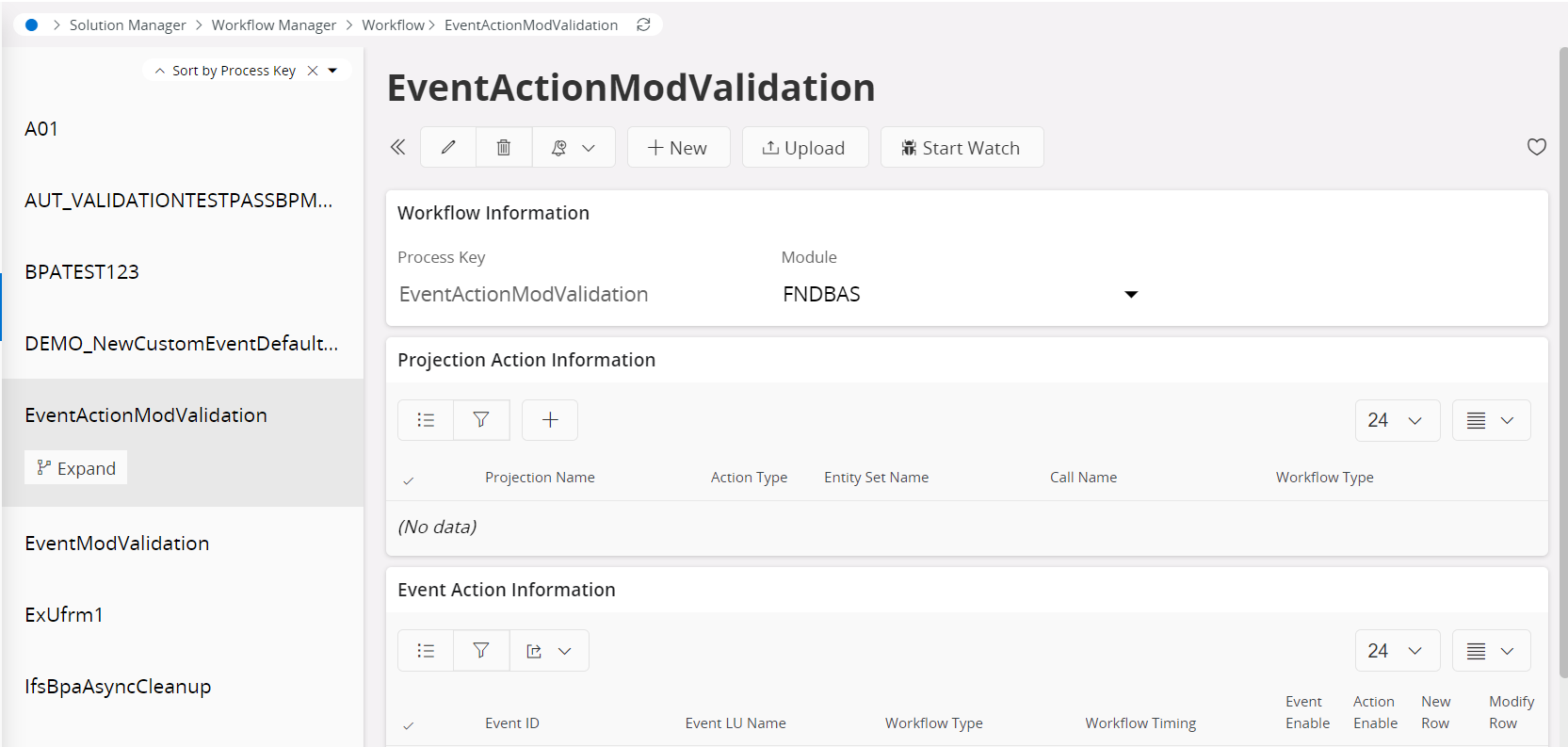
On the left, it displays all the Process Keys for each Workflow which is either created or uploaded by the User.
- Process Key: Unique key that distinguishes between different Workflows
- Module: List down all the IFS Components. If the Workflow is triggered via another component the Module will consist with component name, else the user could select the Module from the drop-down.
Deletion of a Workflow is only permitted when all the versions under the Workflow are undeployed.
| Control | Description |
|---|---|
 |
Used to create a new Workflow or a Workflow Template. |
 |
Used to upload a BPMN file from the File System. |
 |
Used to start watching a workflow. More information can be found in Workflow Observations |
Process Version¶
Each Workflow could consist of different versions based on the changes to the Workflow. Versioning will enable the users to maintain different versions of the same workflow and enabling them to deploy based on the requirements.
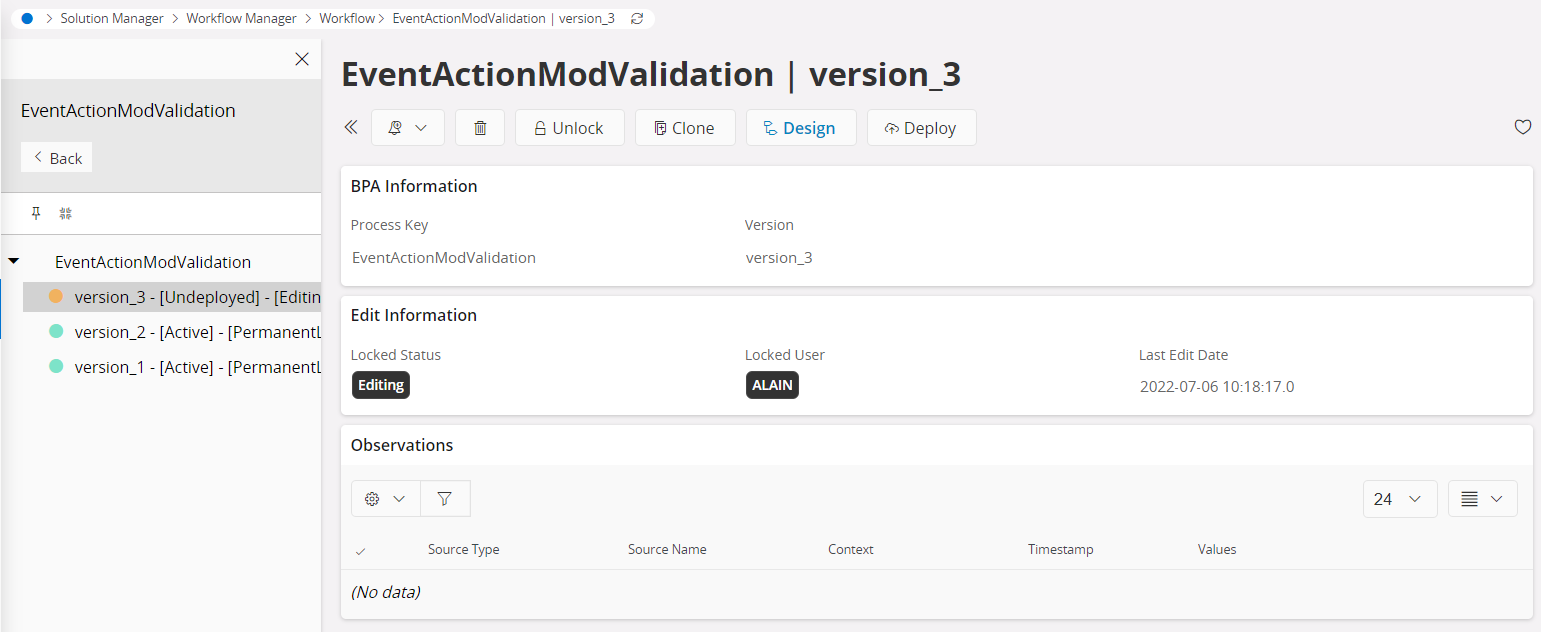
| Control | Description |
|---|---|
 |
Opens the User selected version in the Work Designer. |
 |
Copies the existing version and creates a new version with a user-defined version. |
  |
User can lock a undeployed Workflow version for Editing, which restricts other users from doing changes to that version until the locked user unlocks it. A Workflow admin can unlock the Workflow version by any user. If the Workflow version is deployed, the Lock Button will disappear. |
 |
User can deploy a Workflow version to the server which is then ready to be actioned/used. More information can be found in Workflow Management. |
 |
User can un-deploy a Workflow version from the server. More information can be found in Workflow Management. |
Deletion of a Workflow Version is only permitted when the version is in the Undeployed status. Further deleting the last Workflow version under a Workflow will delete the entire Workflow from the system.
Workflow Information Section¶

Consist with the unique Process Key and the specific Version selected by the User.
Edit Information Section¶

| Label | Status | Description |
|---|---|---|
| Locked Status | Open | The workflow version is open for changes. |
| Editing | The workflow version is currently being edited by a User. | |
| Permanent Lock | The workflow version is the currently deployed version, and no changes are allowed on this version. | |
| Locked User | - | Displays the User who has locked the specific version. |
| Last Edit Data | - | Timestamp for the latest changes in the specific version. |
Deployment Information Section¶

| Label | Status | Description |
|---|---|---|
| Deploy Name | - | Deployment name is specified when deploying the Workflow version. |
| Deploy Status | Active | Currently deployed version. |
| Inactive | Previously deployed version. | |
| Undeployed | Version is never deployed. | |
| Last Deployment Date | - | Workflow version deployed Timestamp. |
| Locked User | - | Displays the User who has deployed the specific version. |
The user can only have one active deployment from the workflow versions created.
Projections¶
A Workflow can be configured to run when a specific projection is called. This is done through a projection action that is attached to the workflow.
What is a Projection Action?¶
Projection Action is the configuration that links a Workflow with a Projection to trigger the Workflow when the Projection is invoked.
There are three types of Workflow Timings which a Workflow can be executed. These timings are defined relative to Projection Execution Time.
- Before
- After
- Asynchronous
Sometimes all of these timings might not be available based on other options that are configured in the Projection Action Configuration. Refer Workflow Timings section for more details about Timings.
There are two main types of projection actions.
- DATA
- CALL
The 'DATA' action type is for reacting to CRUD operations. The 'CALL' type reacts to functions or actions within a projection. When there is a CRUD operation or function/action being performed, workflow will be triggered.
Creating a Projection Action¶
Below are the steps to create a projection action.
Select the workflow from Workflow Manager. Below view is presented when selected.
Click the below control under "Projection Action Information" section.
| Control | Description |
|---|---|
| Open Add Projection Action Wizard |
"Projection Action Configuration" wizard will open. This will guide you through setting up a Projection Action. In the first section, "Projection General Info", select the Projection Name from the searchable drop down list.

Click on "Next".
Next section of the "Projection Action Configuration", "Action Details" will open.
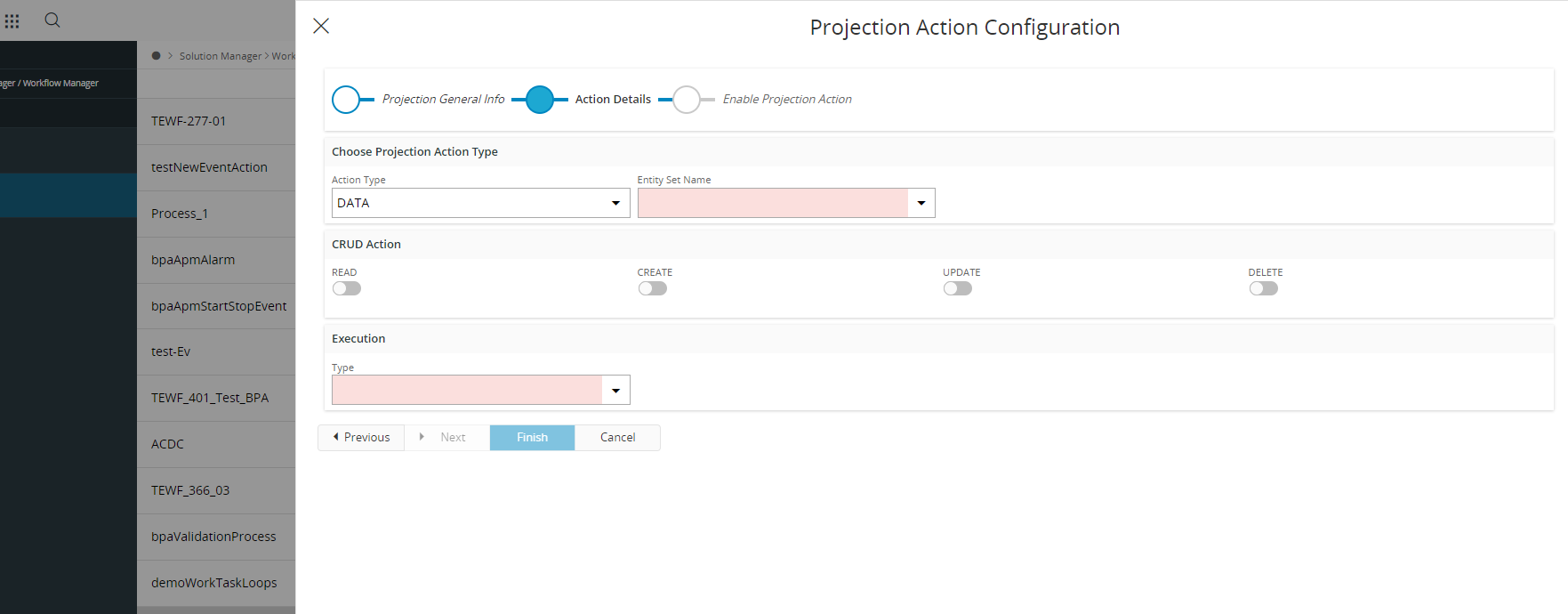
These are the Different options available in the "Action Details" section.
Action Type
| Option | Description |
|---|---|
| DATA | Projection action type is Data |
| CALL | Projection action type is Call |
Entity Set Name
Displayed when the selected "Action Type" is "DATA", the list includes both primary entity sets and nested data collections related to a parent entity instance.
Call Name
This dropdown will only appear if the selected "Action Type" is "CALL". All the Functions/Actions attached to the selected projection from "Projection General Info" section will appear here.
CRUD Action

This Section will only appear if the selected "Action Type" is "DATA". Multiple options can be toggled. This tells Aurena to run the workflow if the Projection does any of the Toggled Actions on the Selected Entity Set.
Type
| Option | Description |
|---|---|
| Validation | Attached workflow type is "Validation" |
| Process Enrichment | Attached workflow type is "Process Enrichment" |
| User Interaction | Attached workflow type is "User Interaction" |
To read further about Workflow Types, please refer Workflow Types.
Timing
Set of options this dropdown can have will change based on what's selected for "Type".
If "Type" is,
- Validation
| Option | Description |
|---|---|
| Before | Workflow will execute before the action done by projection |
| After | Workflow will execute after the action done by projection |
- Process Enrichment
| Option | Description |
|---|---|
| Before | Workflow will execute before the action done by projection |
| After | Workflow will execute after the action done by projection |
| Asynchronous | Workflow will execute Asynchronous of the action done by projection |
- User Interaction
| Option | Description |
|---|---|
| After | Workflow will execute after the action done by projection |
Select the desired options and click "Next". Then "Enable Projection Action" will display. Enable Projection Action and click "Finish".
Enable Projection Action and click "Finish".
Now the workflow is attached with the projection and will be run if the above configured conditions are met.
Executing a Workflow using a Projection¶
This section will show how to run a Workflow attached to a Projection Action.
-
Upload the diagram testProjectionAction.bpmn and deploy.
-
Set up a projection action for uploaded bpmn as below.

-
Now, whenever the work task list is refreshed, testProjectionAction.bpmn will run. For each run, bpmn information will be logged by the Service Task in the bpmn.

| Control | Description |
|---|---|
 |
Refresh the workflow list to execute the Projection Action |
Initiating Workflows From a Projection Delegate¶
A projection call resulted as a Projection Delegate Task execution within a workflow can also be used as the starting point for another Workflow. This is done by creating a Projection Action for the second Workflow with details of the Projection call that is done by the Projection Delegate task of the first Workflow.
Below steps show how create this kind of sample cascade relationship between 2 workflows using Projection Actions.
- Follow Executing a Workflow using a Projection steps (If not already done).
- Upload testProjectionActionCascade.bpmn and deploy.
- Set up Projection Action for testProjectionActionCascade.bpmn as below.

Now, when the workflow list is refreshed, A regulatory body is added and from testProjectionAction.bpmn. Workflow testProjectionActionCascade.bpmn is then run as testProjectionAction.bpmn invokes RegulatoryBodyHandling -> create RegulatoryBodySet.
Note:¶
Make sure to delete Regulatory body with the code 'PRACT' from list when testing is done.
Events¶
Relationship between a Workflow, Camunda Deployment and Event Configuration¶
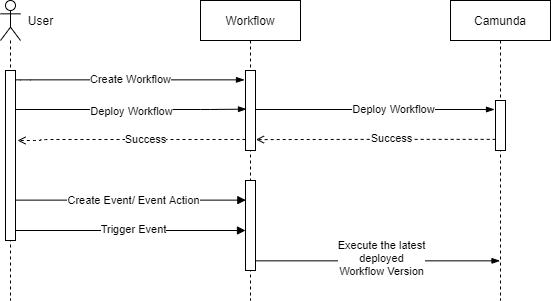
A user can create a Workflow using the Workflow Manager in the IFS Cloud. The Workflow Manager enables the user to manage multiple Workflow versions of the same Workflow. Once a Workflow version is deployed to the Camunda Engine Camunda will refer this version as the latest version. The user can create an Event for a particular Workflow and at runtime the Event action will be associated with the latest deployed version in Camunda Engine. Upon triggering the Event the latest deployed Workflow version in the Camunda Engine will be executed. Therefore, even if the deployed Workflow version is not available in the Workflow Manager the user will still be able to execute the event action successfully.
Invoking A Workflow¶
To invoke a Workflow within IFS Cloud the following are required:
Custom Event¶
To be able to invoke a Workflow, a Custom Event needs to be configured within the system. The information for this can be found in the Custom Event section.
Business Process Automation Configured In Workflow Designer¶
The Workflow is then required to be set up within the Workflow Designer with the relevant BPMN steps of the Workflow to configure the output that is required. Refer to the Workflow Designer and BPMN sections for more information.
Event Action¶
A new Event Action Type named “Workflow” has been added to allow the invoking of a Workflow within IFS Cloud, the Event Action then needs to be referenced to the Custom Event that has been created along with providing a description.

Then hit Next:

The Workflow key that is assigned to the Workflow within the Workflow Designer needs to be referenced in the Workflow ID field of the Event Action. The Workflow key is located when you click off of any of the BPMN shapes in the Workspace area and the key is then visible on the Properties Panel. The following example shows the key bpaStateHandling:
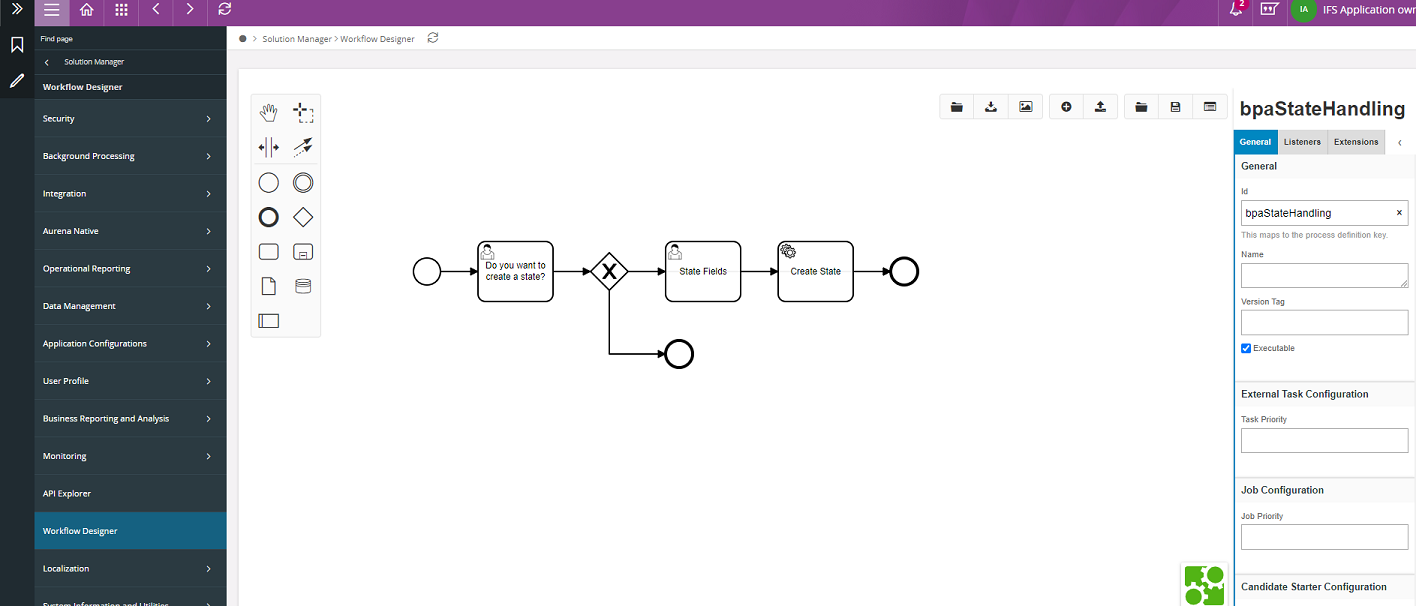
Next step of the Event Action creation is to choose the type of Workflow; the different types of Workflow are explained in the Type of Workflow section.
There are two different timings relative to the Event Action when a Workflow can be invoked; the different types of workflow timings are explained in the Workflow timings section. These timings represent different stages of a transaction, or REST request where the Workflow can be invoked. Once the Event Action has been enabled, then the Workflow is ready to be tested to ensure it works as expected.
Event Action Information Section¶

Event Action Information section lists all the Event Actions assigned for the specific Workflow version. Refer invoking a workflow section for more information on events.
Workflow Designer¶
IFS Cloud includes the ability to edit business processes using the Workflow Designer, embedded within the Workflow Manager. This UI allows the users to configure Workflow using a drag and drop user interface. It provides our users with the ability to visually see what the correct output would be based on the conditions provided by the user and also providing the ability to model BPMN graphical flow charts.

The Workflow Designer is separated into 4 sections:
Toolbox¶
The toolbox is where all the different BPMN shapes are situated. This is where the different tasks, events, and other tools the Workflow Designer has allows the user to perform drag and drop functionality. A symbol can be dragged to the workspace which can then be used to construct your Workflow.

| Control | Description |
|---|---|
 |
Used to drag and move the Workflow within the Workspace to a different point of the screen. |
 |
Used to group the different BPMN symbols within the workspace, to then perform actions such as move or delete. |
 |
To create space between BPMN symbols. |
 |
To connect BPMN symbols. |
[^need to change this line]:
Workspace¶
This is where you add your different BPMN shapes to the Workflow itself which is in between the Toolbox and the Properties Panel.

Control Panel¶
Need to upload new image.
Allows the user to perform the following actions,
| Control | Name | Description |
|---|---|---|
 |
Download Workflow | Ability to download the Workflow BPMN file from within the browser. |
 |
Download as SVG Image | Download the Workflow as an image. |
 |
Validate BPMN Diagram | Validates the current BPMN Diagram and displays the validation errors. |
 |
Inspect BPMN Diagram | Ability to Troubleshoot Workflow. |
 |
Deploy Workflow | Deploys the diagram to the server which is then ready to be actioned/used |
 |
Save Workflow As | Save Workflow To Server. |
 |
Toggle Properties Panel | Show/Hide Properties Panel. |
Properties Panel¶
This is a dynamic panel based on which BPMN symbol you have selected within the Workspace. The Properties Panel is used to enter the additional configuration information required for a specific task, event, etc.

Troubleshooting¶
Troubleshooting allows the user to execute a Workflow and inspect the execution path, along with the relevant variables through the Workflow designer. This functionality would enable the capability to troubleshoot the Workflow before any deployments.
Troubleshoot a Workflow¶
Through the below button, the User could start troubleshooting. Troubleshooting can be done for an already deployed Workflow or a newly created Workflow.

Once clicked, the below window will appear and the User could provide the inputs required for the Workflow execution.

Note: Above values are subjected to changes based on the Workflow.
In case, the Workflow consists of any event action configured, the drop-down from the above dialog box could be used to select it. Through this selection, there is no business value to the troubleshooting functionality, but it will automatically fill the input fields according to the configured logical unit in the event action.
Below elaborates a scenario where an Event Action is configured,
E.g. Assume an Event Action, which consists of a logical unit as 'StateCodes'. In such a scenario, once the event action is selected, the properties defined for the 'StateCode' will be automatically filled as inputs.

Note: Troubleshooting could be enabled without any inputs.
Save, Load and Keep Inspection Data¶
Users can save their inspection data for future use by clicking the save button on the 'Inspect BPA' popup dialog. It will automatically download a JSON formatted file named 'info.json' and it can be loaded later.
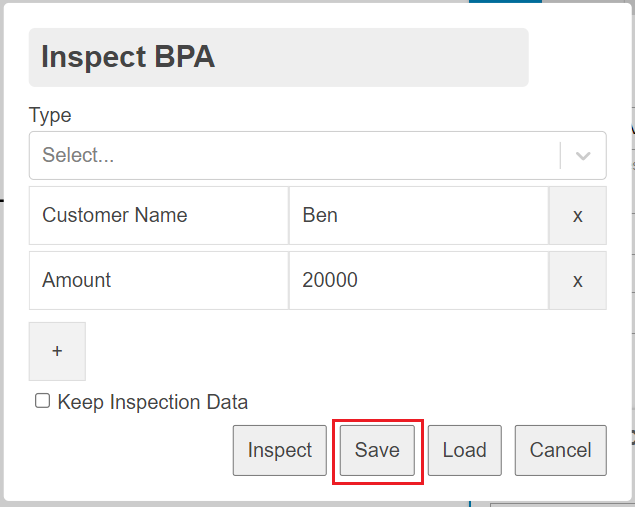
The saved 'info.json' file can be loaded by clicking on the 'Load' button.
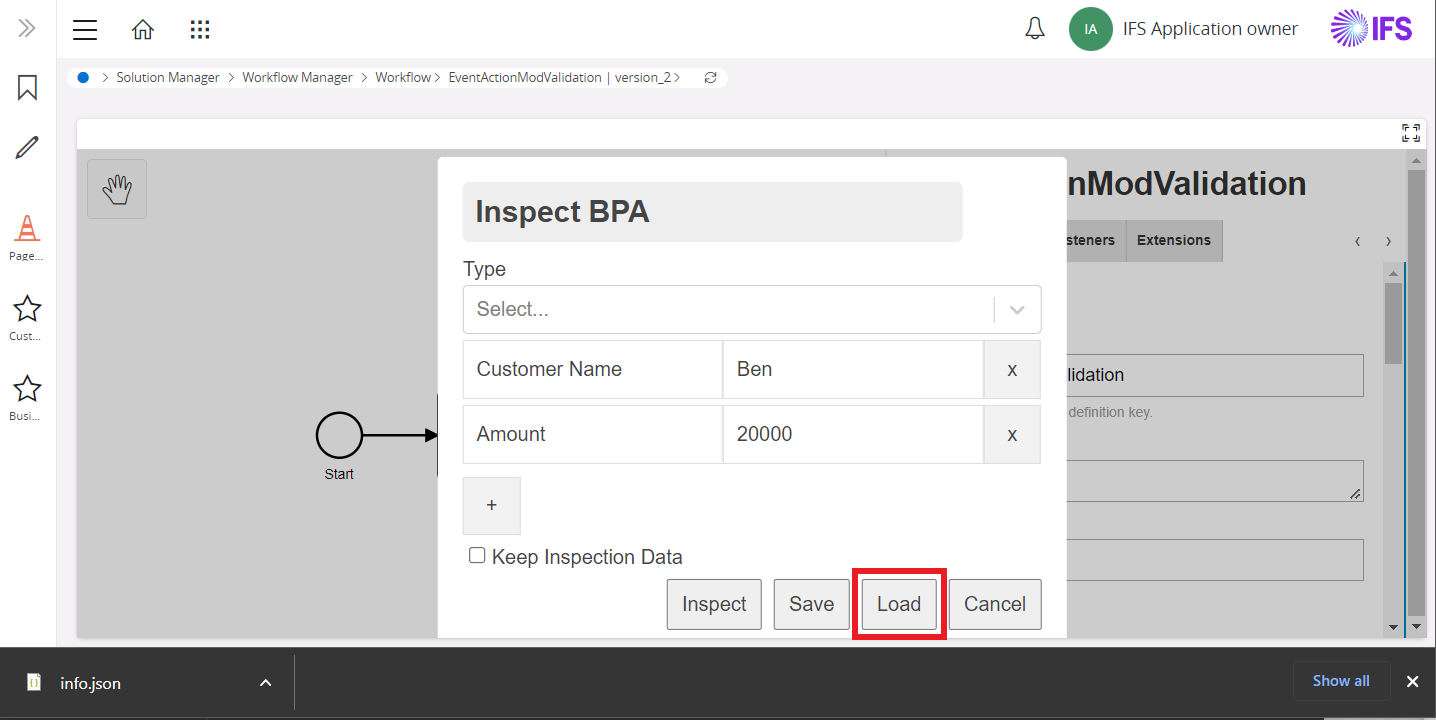
It will popup the 'Upload file' dialog and select the downloaded 'info.json' file to upload it.

It will load the previously saved inspection data successfully with a toast message.
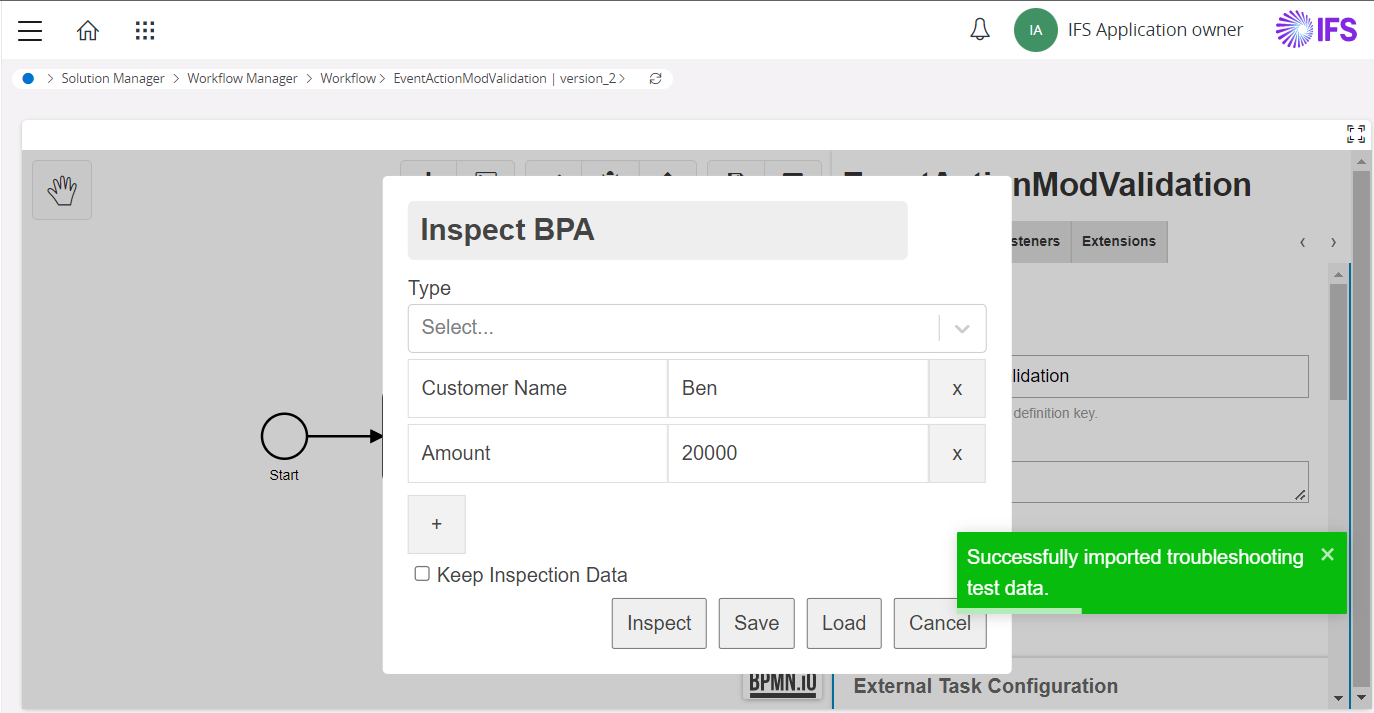
Clicking on the 'Keep Inspection Data' checkbox will enable you to keep your inspection data for this session and no need to add data again and again.
Underlying Process in Troubleshooting a Workflow¶
Upon clicking the 'Inspect button', the execution path of the Workflow will be displayed to the User. The below diagram elaborates the high-level tasks that occur in the background.
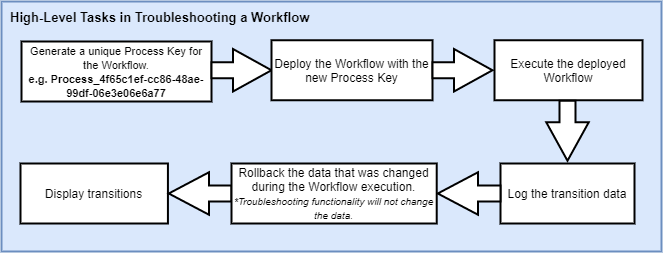
Below displays the results of troubleshooting a Workflow, where the eye icons show the execution path. Users can hover through the eye icons and view the variables and their values at each occurrence.
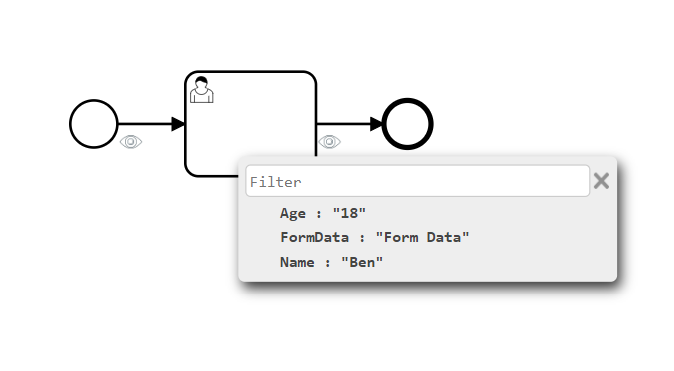
Troubleshoot a Workflow with User Forms¶
When a Workflow contains User Forms, troubleshooting functionality will prompt the user to enter values. It executes the Workflow by considering the values entered. Below contains the scenario of a User Form.

<bpmn:userTask id="Activity_1hs02sa" camunda:formKey="form1">
<bpmn:extensionElements>
<camunda:formData>
<camunda:formField id="CustomerName" type="string" />
<camunda:formField id="Payment" type="long" />
<camunda:formField id="Paid" type="boolean" />
</camunda:formData>
................................................
</bpmn:userTask>
Once the user clicks on troubleshoot button, then the user form will be prompted.
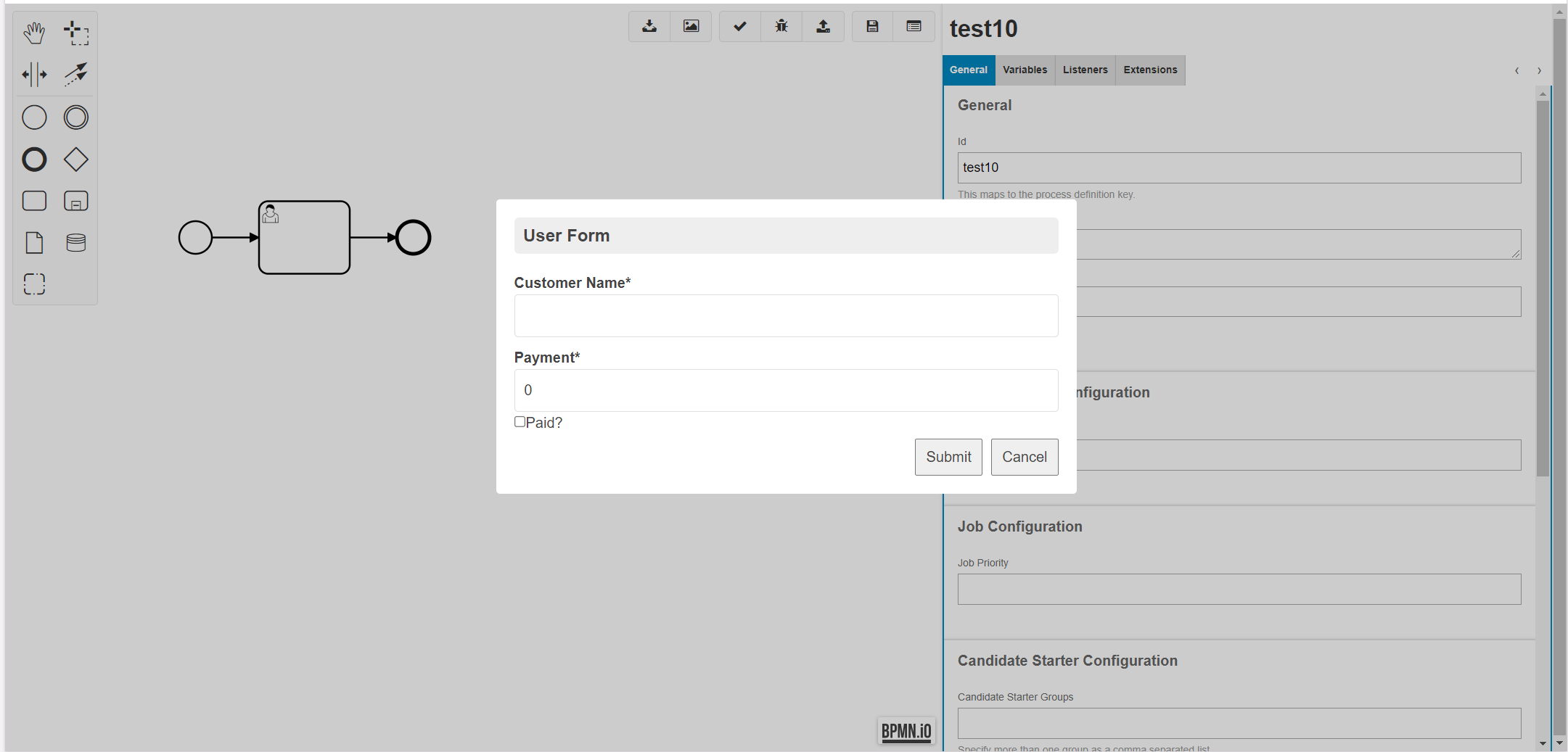
User should enter the mandatory values and the optional values will be replaced by default values.

Below displays the results of troubleshooting a Workflow with user form, where the eye icons show the entered user form data. Users can hover through the eye icons and view the variables and their values.

Troubleshoot a Workflow with Loops¶
Troubleshooting tool supports looping. The below workflow contains a collection of records and the sub process activities loop through it.
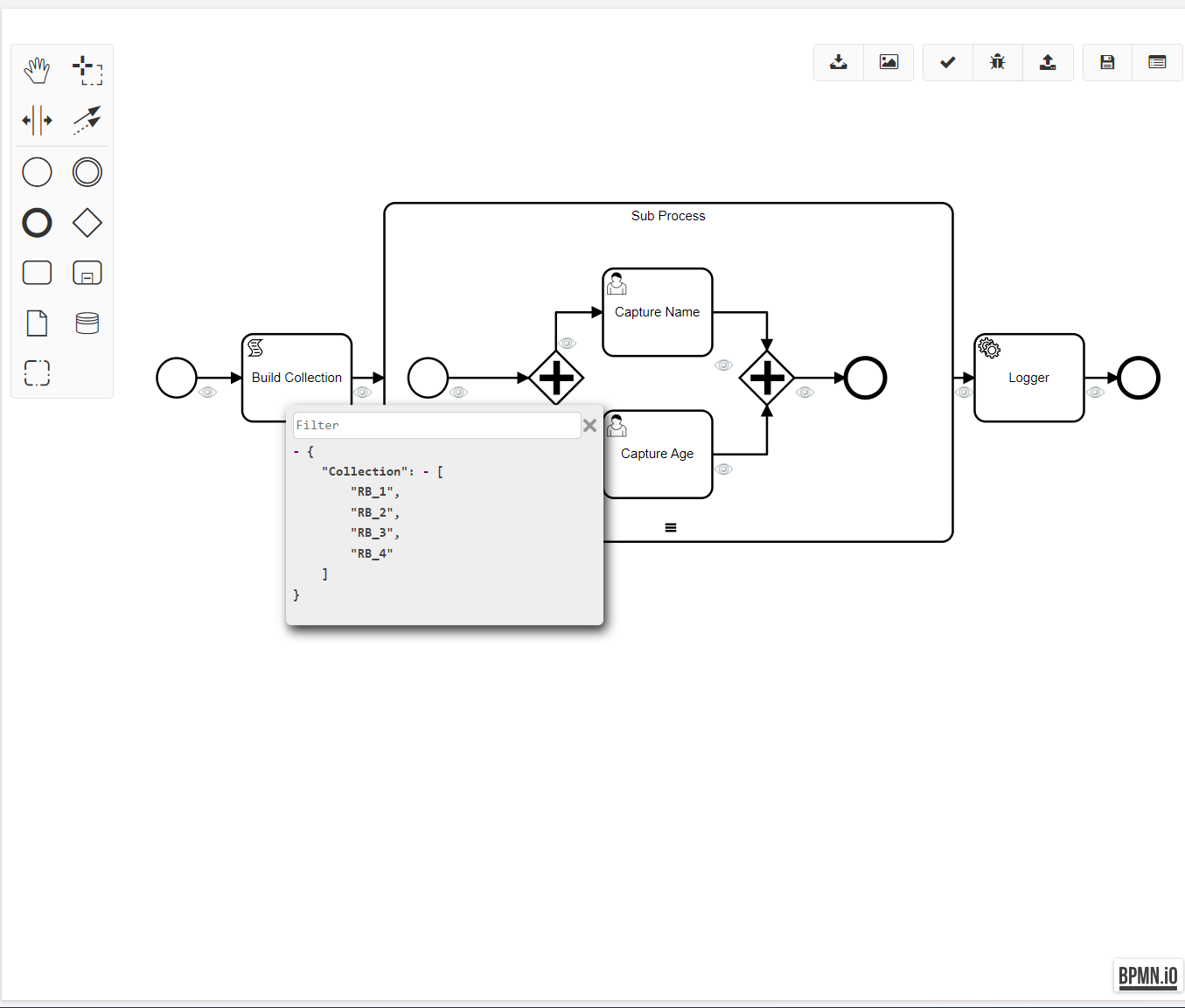
User forms will be prompted to enter data in each cycle. Once user clicks on the troubleshooting eye icon, then the data will be shown per each cycle as a pagination. The below image shows the data values of the first iteration.
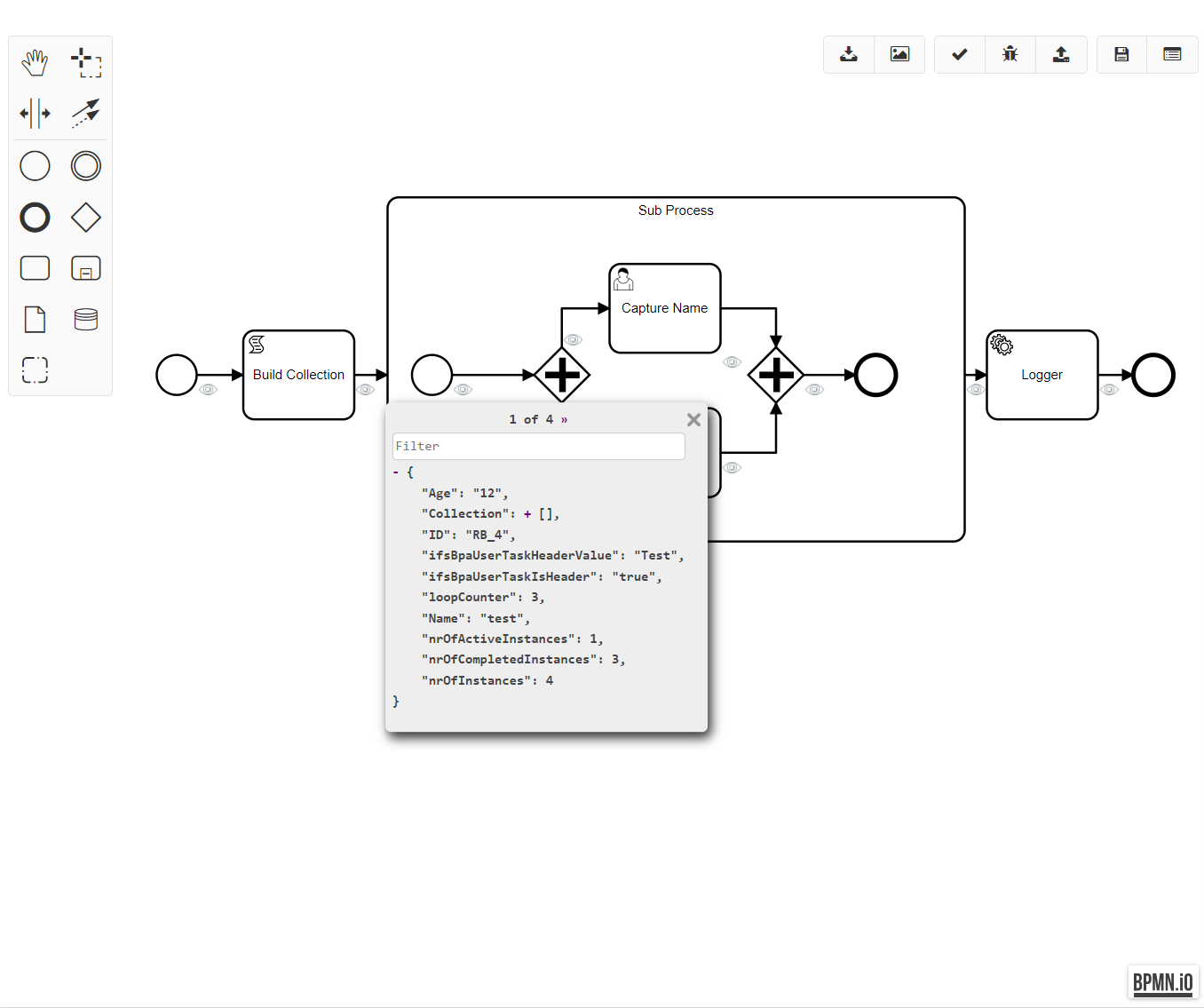
Users can click on the left or right arrows of the pagination to checkout the data values for each iteration.
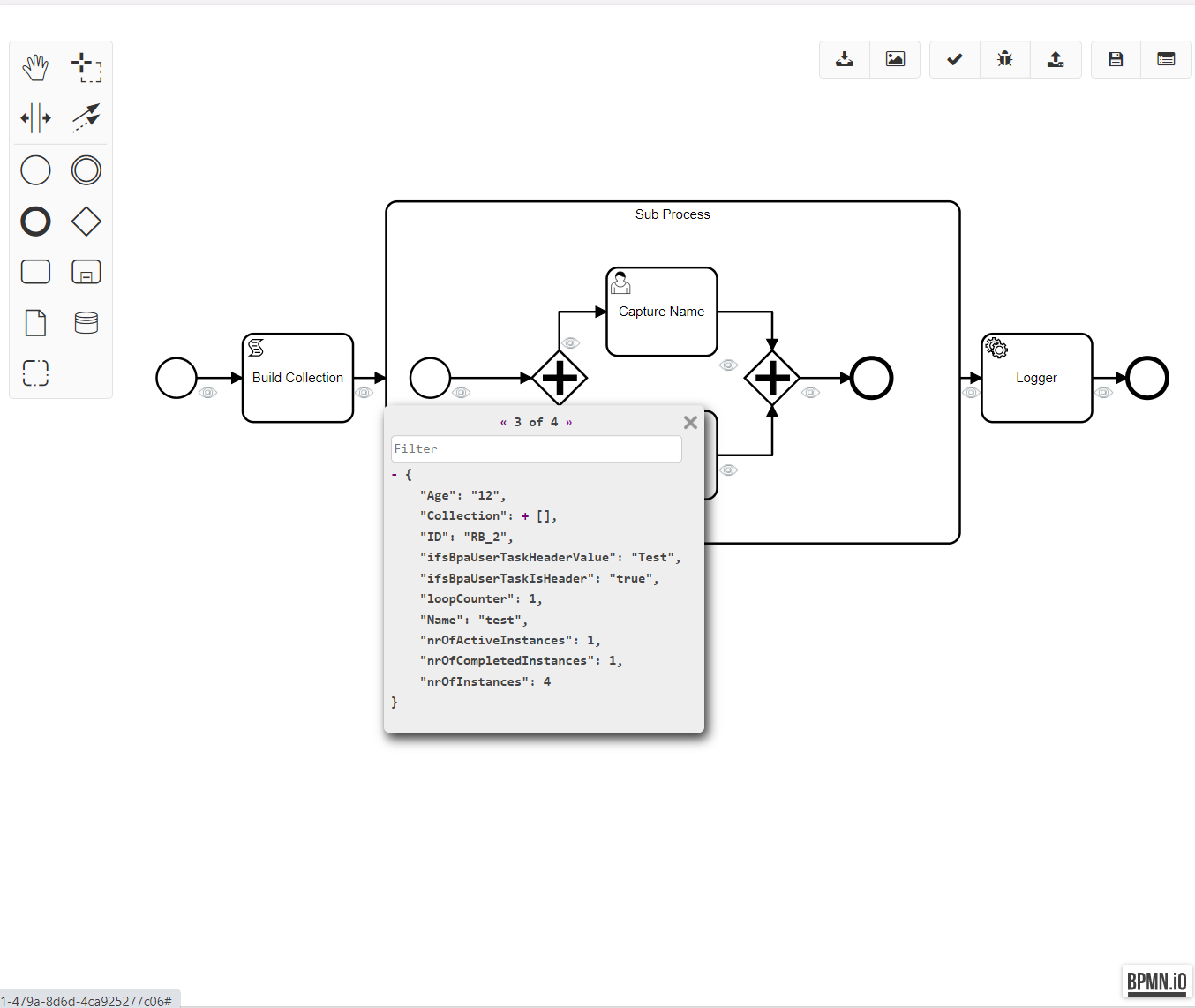
Troubleshoot a Workflow with Cascades and Projection Actions¶
Troubleshooting supports workflows that contain cascades and projection actions. There are two new icons have been used to indicate that the cascade or projection action has been triggered.
- P - The 'P' icon has been used to indicate that there is a projection action has been triggered.
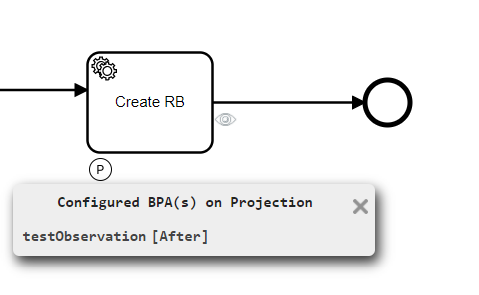
- E - The 'E' icon has been used to indicate that there is a cascade has been triggered.

Troubleshooting Errors¶
Whenever there is an error in Workflow execution, that will be shown to the user in a meaningful manner. The execution eye icons will be displayed up to the point where the error occurs and another red-eye icon will be displayed at the last point. Users can see the error message by hovering over the red icon. Refer to the below scenario.

The above Workflow requires Age as an input, when it is troubleshooting without the required input below error is visible at the gateway.

Workflow Observations¶
Workflow observations tool can be used to record inputs to workflows for later use within troubleshooting tool.
Start Watching¶
Users can start watching a workflow by clicking on 'Watch' button in workflow manager.
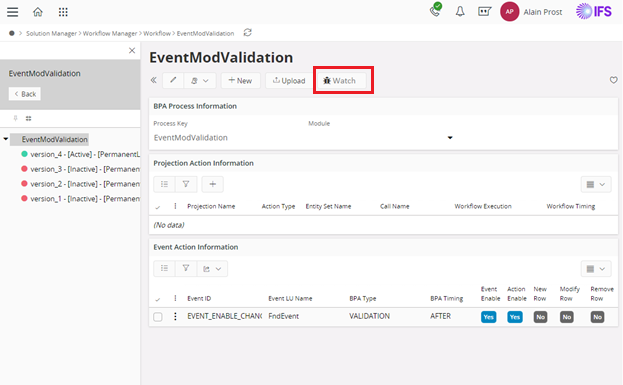
This will Start logging executions of Workflows for this Process until either 15minutes have passed, the Workflow is re-deployed or the user disabled watching. Starting logging deletes all previous logs for this User / Process combination. Additionally, a toast will be displayed reminding the user that watching will be available for 15 minutes.
Stop Watching¶
The 'Stop Watch' button will disable watching the start of workflow invocations for this process.
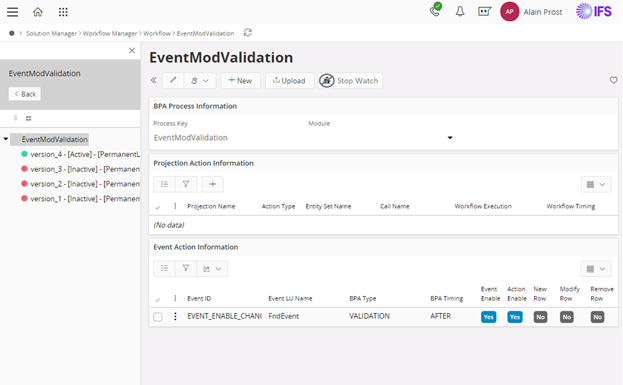
View Executions¶
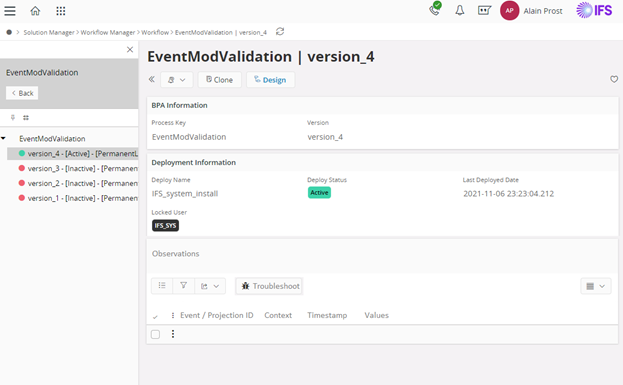
Observations: Shows all observations registered in the most recent ‘Watch’ that were logged in the last hour. Troubleshoot: Launches the Troubleshooting dialog with values pre-populated (see next step) for a single observation. The following data is displayed (Read Only)
- Event Id or Projection Name triggering the Workflow
- Context (oData / Delegate) in which the Workflow was triggered
- Timestamp of when the Workflow was triggered (useful for sorting)
- Logged Values – ideally displayed using the same format as persisted in the Troubleshooting dialog
Troubleshoot an Execution¶
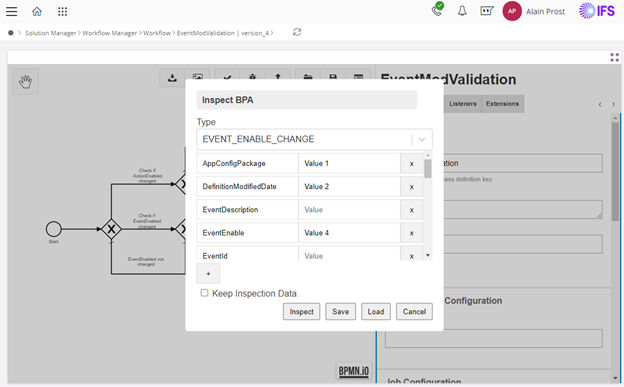
When Troubleshooting is invoked from an Observation the Workflow Designer is launched with the Troubleshooting dialog active and populated. All the other Troubleshooting tools will remain available, including the ability to Save the data for use in the future.
Workflow Status¶
The Workflow Status provides the user with an at-a-glance view of information related to Workflows.
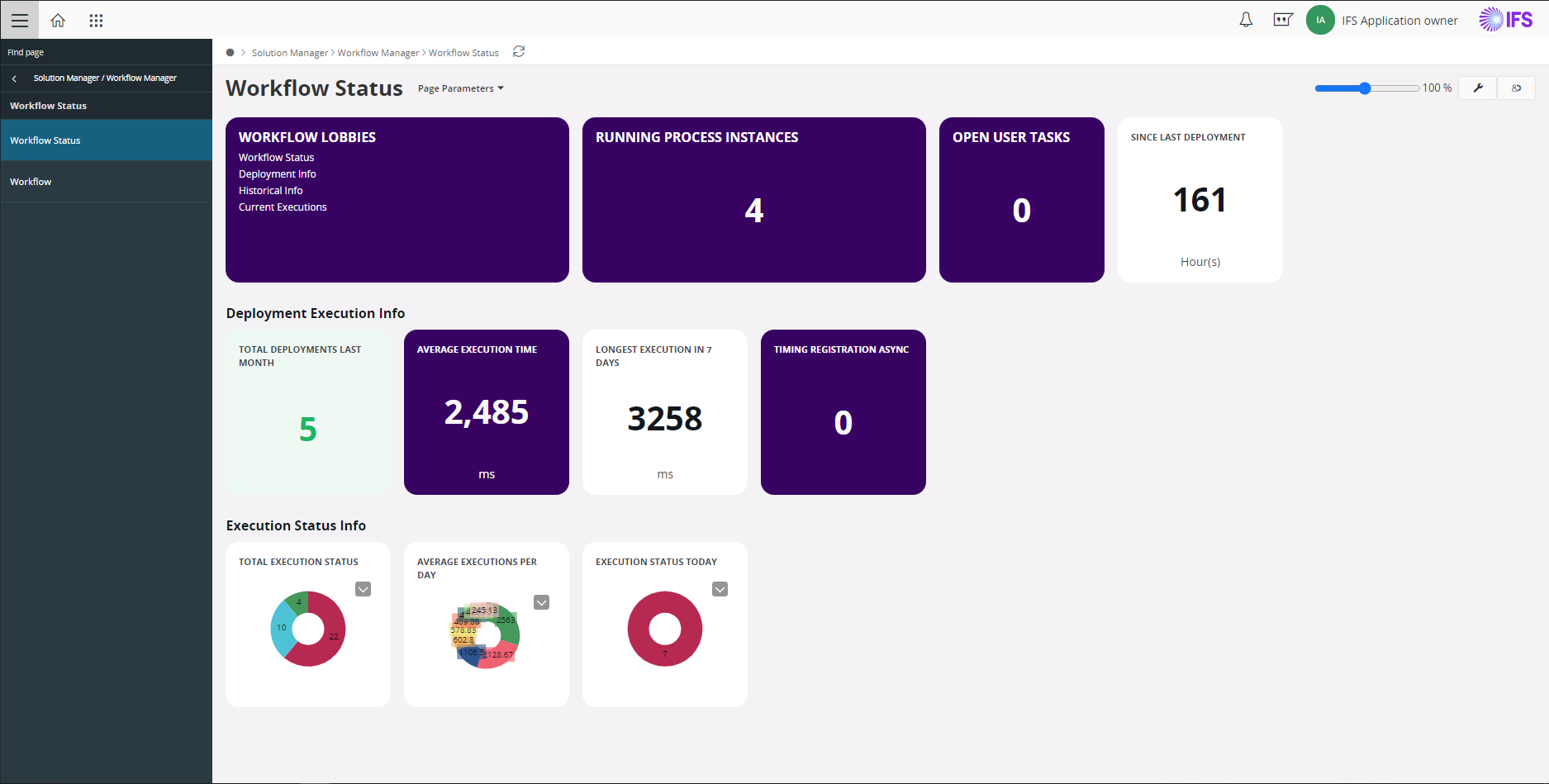
Below are the Workflow Lobbies available for a user to view required information,
Workflow Status¶
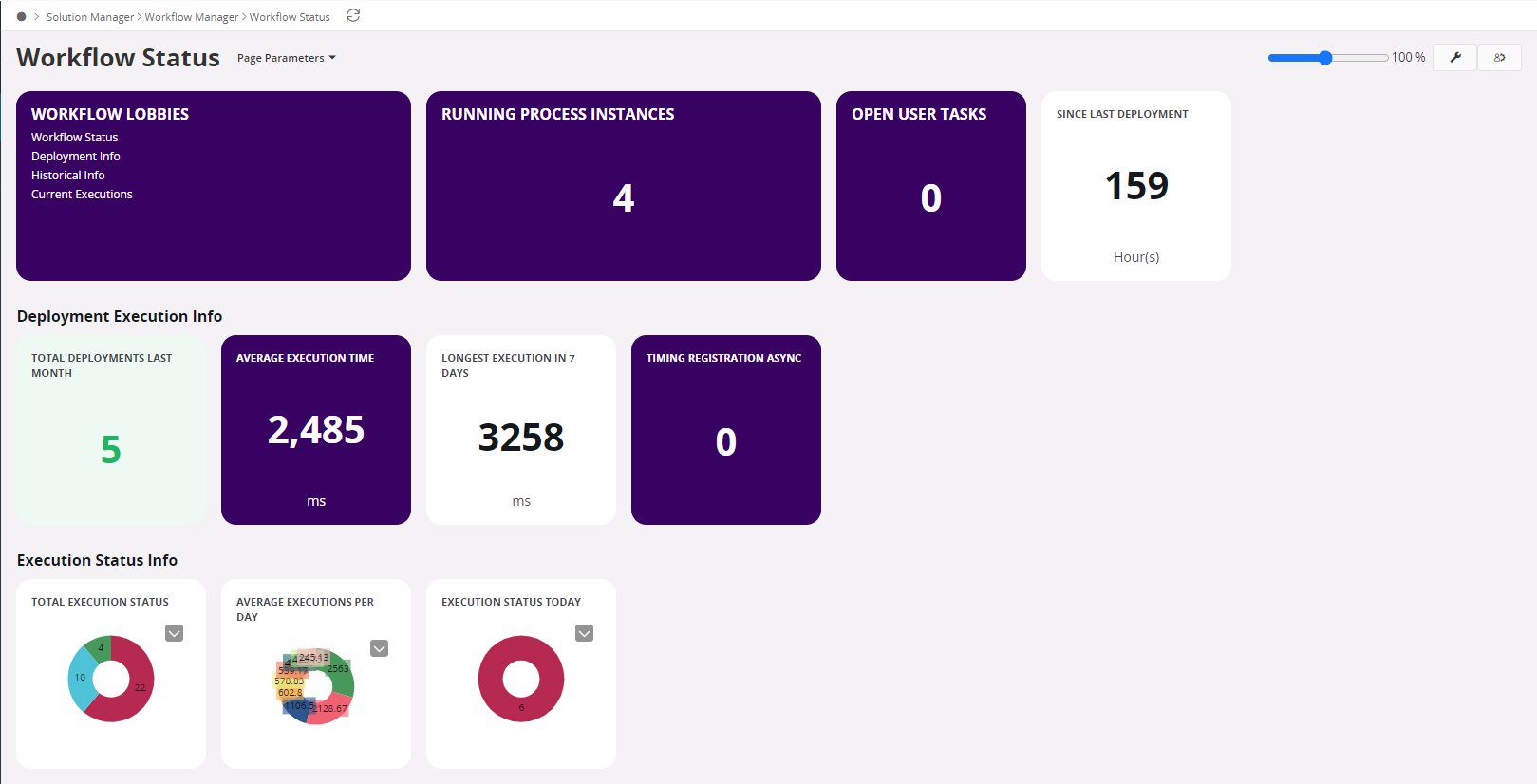
| View | Name | Description |
|---|---|---|
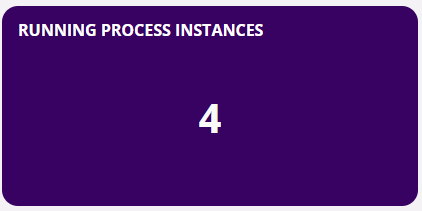 |
Running Process Instances | The number of currently running Workflow. |
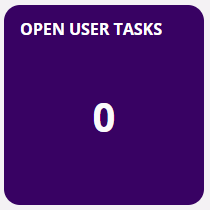 |
Open User Tasks | The number of open user tasks. |
 |
Since Last Deployment | Time in hours, since the last deployment has happened. |
Note: Above numerical values are subject to changes based on Workflow executions.
Deployment Execution Info¶

| Name | Description |
|---|---|
| Total Deployments Last Month | The number of Workflow deployments done during the previous month. |
| Average Execution Time | Average execution time in milliseconds. |
| Longest Execution in 7 Days | Longest execution time taken during the last 7 days. |
| Timing Registration Asynchronous | The number of ASYNC Workflows in the system. |
Note: Above numerical values are subject to changes based on Workflow executions.
Execution Status Info¶
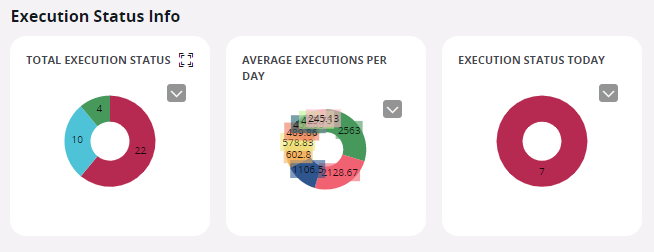
| Name | Description |
|---|---|
| Total Execution Status | Number of Workflows that are Deployed, Active and Inactive in the system. |
| Average Execution Per Day | Average execution time of the Workflow each day. |
| Execution Status Today | Number of Workflows executed during the current day categorized on deploy status. |
Note: Above numerical values are subject to changes based on Workflow executions.
Workflow Deployment Data¶
Users could browse to Workflow Deployment Data by clicking on Deployment Info from the Workflow Lobby.
| View | Name | Description |
|---|---|---|
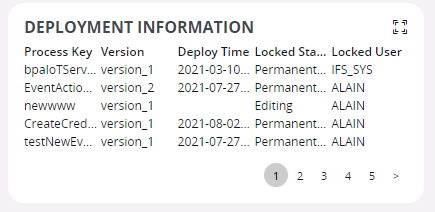 |
Deployment Information | The deployment information for each Workflow. |
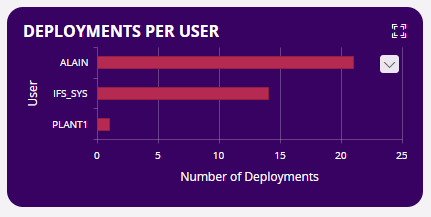 |
Deployments Per User | The number of Workflow deployments per user. |
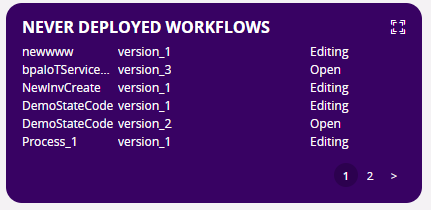 |
Undeployed Workflows | The number of Workflows that are under the UNDEPLOYED status. |
Workflow Historical Data¶
Users could browse to Workflow Historical Data by clicking on Historical Info from the Workflow Lobby.
| View | Name | Description |
|---|---|---|
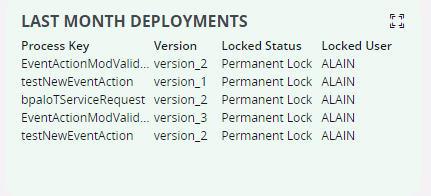 |
Last Month Deployments | Workflow deployment information for the previous month. |
 |
Top 5 Longest Executions | Displays the top 5 Workflows which are having the longest execution time. |
Workflow Runtime Data¶
Users could browse to Workflow Runtime Data by clicking on Current Executions from the Workflow Lobby.
| View | Name | Description |
|---|---|---|
 |
Running Instances | Detailed information regarding the currently running Workflow. |
 |
Events | Event details related to the Workflow. |
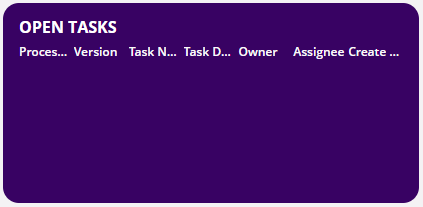 |
Open Tasks | Detailed information related to the currently open user tasks. |
 |
Open Task Variables | Detailed information regarding open task variables. |
Workflow Templates¶
Workflow patterns and best practices can be easily understood by referencing a Workflow used to solve a similar problem. Workflow templates provide users with the ability to manage and view templates within the application which can be leveraged and build upon. Workflow templates are intended to create and deliver patterns to users by including a few examples of best practices.
Workflow templates are not executable but can be inspected. The troubleshoot functionality works the same as non-template workflows allowing users to understand how the Workflow could benefit IFS Cloud users. The 'Is Template' attribute is shown in the 'Workflow Information' section, indicating whether the Workflow is a template or executable.

Create a Workflow Template¶
Step 1 : Click the “New” button.
| Control | Description |
|---|---|
 |
Used to create a new Workflow or a Workflow Template. |
Step 2 : Provide the Process Key, and enable "Is Template".

Clone a Workflow Template¶
Step 01 : Click the “Clone” button.
| Control | Description |
|---|---|
 |
Copies the existing version and creates a new version. Or copies the existing version and creates a new Workflow with a user-defined Process Key. |
There are two ways to clone a Workflow Template:
Step 2a : Click 'Clone version for Same Workflow'.
Copies the existing Workflow Template version with a user-defined version under the same Workflow Template.

Step 2b : Click 'Clone as a new Workflow'.
Users can copy the Workflow Template version as a new non-template Workflow with a user-defined process key.

Mark Workflow as a Workflow Template¶
Step 1 : Click the "Mark As Template" button.
| Control | Description |
|---|---|
 |
Mark a non-template Workflow as a Workflow Template |
The eligibility criteria to Mark a Workflow as a Workflow Template is as follows,
- The workflow should be a Non-Template Workflow.
- All Workflows versions of the Workflow should be in the un-deployed status (If a Workflow has at least one Active/ Inactive version, then it cannot be marked as Workflow Template).
Upload a Workflow Template¶
Users can set the 'isExecutable' attribute in the BPMN XML file to false. Use the existing “Upload” button available within the Workflow page to upload the Workflow as a Workflow Template.
Workflow Management¶
The Workflows page is accessible within the Solution Manager section in IFS Cloud for users to manage the existing Workflows within the system. The page also displays information about the deployments, improving the filtering and searching experience.

Deploy a Workflow¶
Step 1: Select a currently inactive or undeployed Workflow.
Step 2: Click the "Deploy" button.
| Control | Description |
|---|---|
 |
Deploys the diagram to the server which is then ready to be actioned/used. |
The 'Deploy' button will be visible only for Undeployed or Inactive Workflows. The deployment will take place the same as in the Workflow Designer. More information can be found in Getting Started with Workflows.
Step 3: Provide a deployment name.
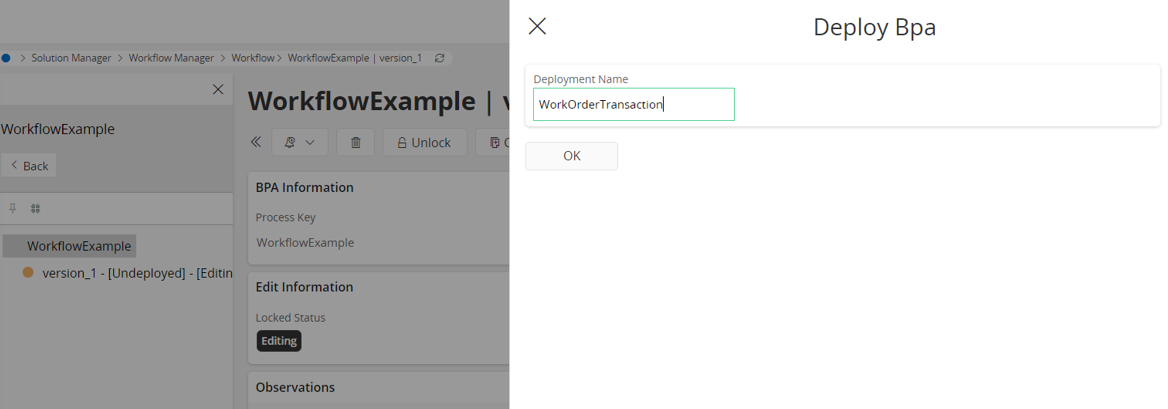
Un-deploy a Workflow¶
Step 1: Select the Workflow Version.
Note: Un-deployment is not available for system installed Workflows. (If the Deployment Name is 'IFS_System_install' or the column header IFS Provided is set to 'Yes').
Step 2: Click the "Undeploy" button.
| Control | Description |
|---|---|
 |
Un-deploys the diagram from the server. |
The un-deployed Workflow version will be set to undeployed status and is allowed to edit.
Note: If a Workflow consists of only one version and contains any active configurations (Projection Action Configurations/ Event Action Configurations), un-deployment is not permitted.
When multiple Workflow Versions are deployed for the same Workflow, the previously deployed Workflow Version will be automatically activated as the deployed version. For example, the below Workflow consists of two Workflow Versions, where version_1 is Inactive (previously deployed version) and version_2 is Active (currently deployed Workflow Version).

When version_2 is undeployed, the system will automatically activate the previous deployment and version_2 will be set to undeployed status, also allowing for editing to occur.
